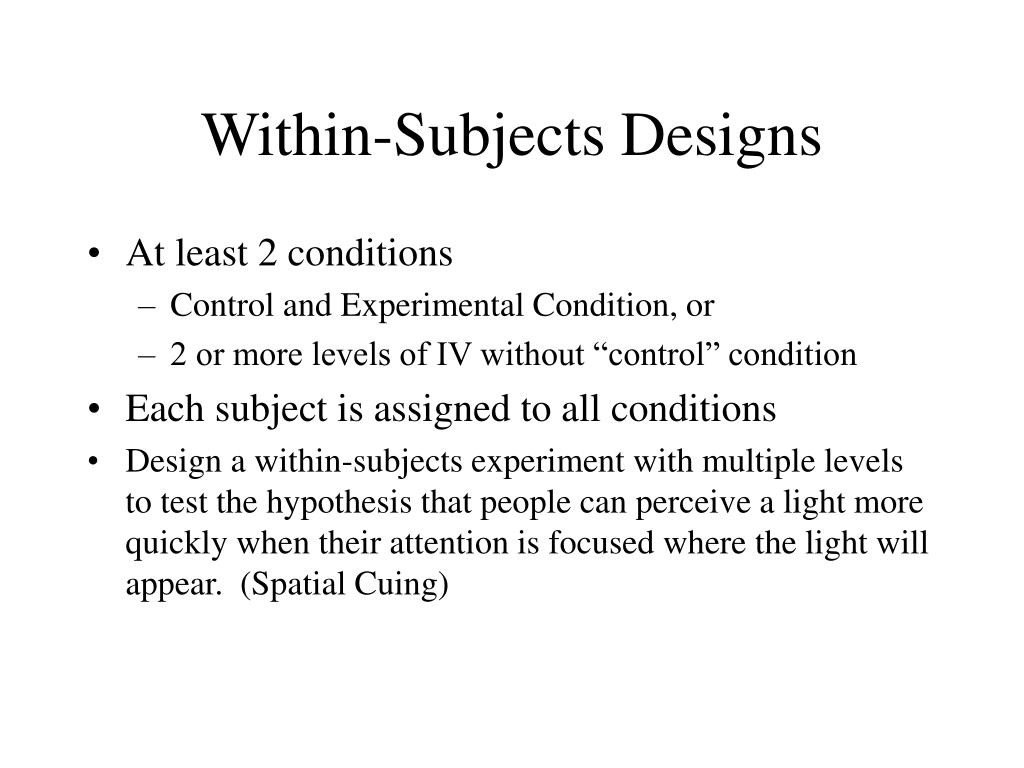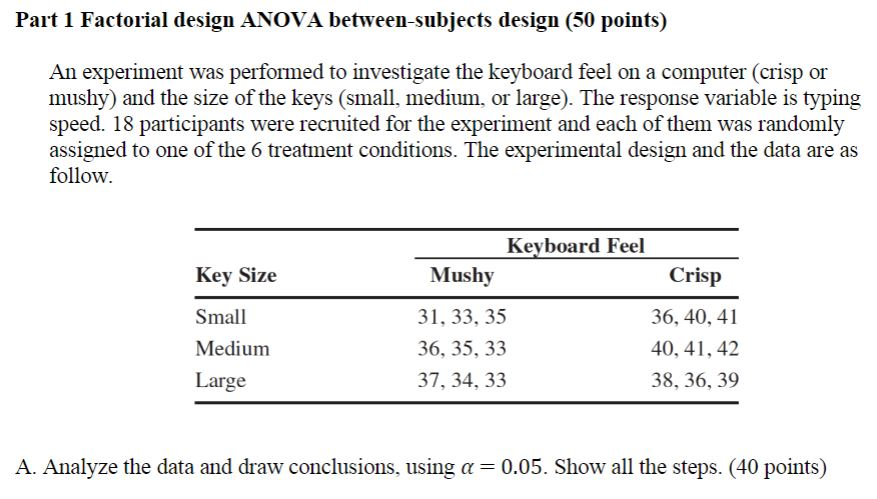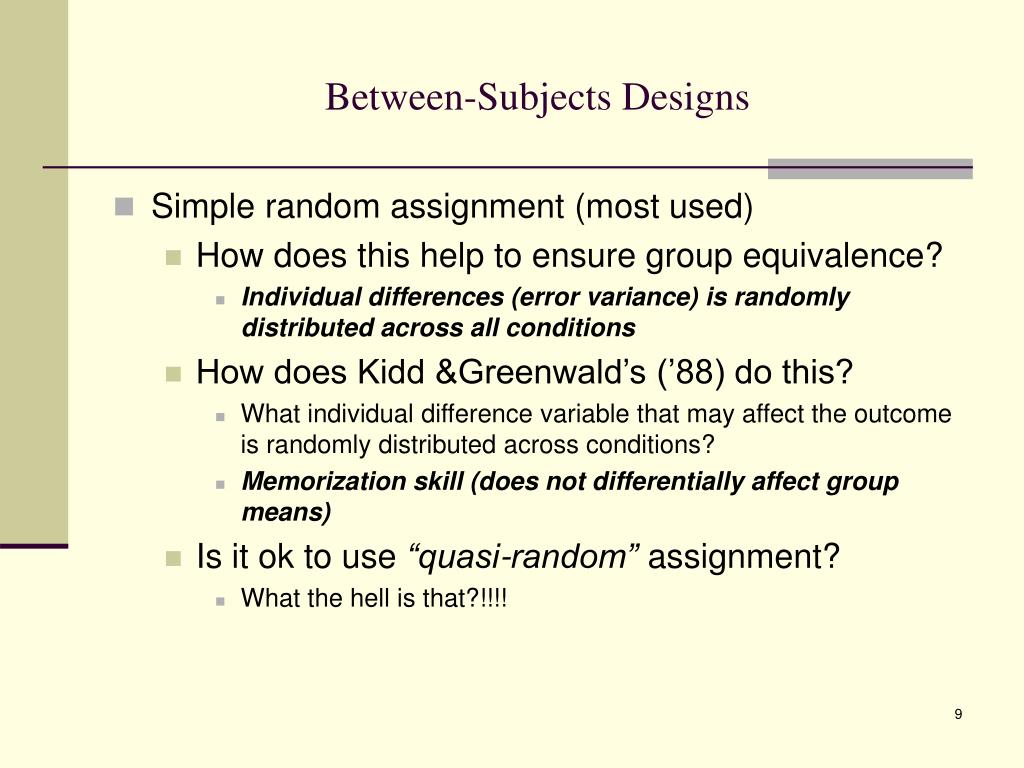Table Of Content

Participants in all conditions have the same mean IQ, same socioeconomic status, same number of siblings, and so on—because they are the very same people. Within-subjects experiments also make it possible to use statistical procedures that remove the effect of these extraneous participant variables on the dependent variable and therefore make the data less “noisy” and the effect of the independent variable easier to detect. However, not all experiments can use a within-subjects design nor would it be desirable to do so. An alternative to simple random assignment of participants to conditions is the use of a matched-groups design. Using this design, participants in the various conditions are matched on the dependent variable or on some extraneous variable(s) prior the manipulation of the independent variable.
Two Ways to Plan Your Study
Carryover effects between conditions can threaten the internal validity of a study. A carryover effect is an effect of being tested in one condition on participants” behavior in later conditions. Shows how each level of one independent variable is combined with each level of the others to produce all possible combinations in a factorial design. Regardless of whether the design is between subjects, within subjects, or mixed, the actual assignment of participants to conditions or orders of conditions is typically done randomly. In that case, the use of within subject design will be impossible because the repeated use of the same actions will badly affect the study`s objectivity.
Ways to assign conditions to test participants
How to Write the Method Section of an APA Format Psychology Paper - Verywell Mind
How to Write the Method Section of an APA Format Psychology Paper.
Posted: Tue, 14 Mar 2023 07:00:00 GMT [source]
The between-subjects design is conceptually simpler, avoids order/carryover effects, and minimizes the time and effort of each participant. The within-subjects design is more efficient for the researcher and controls extraneous participant variables. Our goal was thus to investigate whether the production effect differentially relies on recollection and familiarity in within-subject and between-subjects designs. Experiments 1a and 1b compared the magnitude of the production effect, as indexed by estimates of recollection and familiarity across between- and within-subject designs using remember-know responses (Gardiner, 1988; Tulving, 1985). Experiments 2a and 2b next replicated our results using estimates of recollection and familiarity derived from simple confidence ratings using a dual-process signal detection framework (Yonelinas, 1994, 1997).
A Single-Process Interpretation: Only Memory Strength
In doing so, we were able to calculate metrics comparable to measures of response bias and sensitivity within a broader signal detection framework (see Wright et al., 2009; Wright & London, 2009). There is a solution to the problem of order effects, however, that can be used in many situations. It is counterbalancing, which means testing different participants in different orders. The best method of counterbalancing is complete counterbalancing in which an equal number of participants complete each possible order of conditions. For example, half of the participants would be tested in the attractive defendant condition followed by the unattractive defendant condition, and others half would be tested in the unattractive condition followed by the attractive condition. With three conditions, there would be six different orders (ABC, ACB, BAC, BCA, CAB, and CBA), so some participants would be tested in each of the six orders.
Behavioural reconsolidation interference not observed in a within-subjects design npj Science of Learning - Nature.com
Behavioural reconsolidation interference not observed in a within-subjects design npj Science of Learning.
Posted: Tue, 11 Oct 2022 07:00:00 GMT [source]
Between subjects design, also known as an independent groups design, is a research method commonly used in experimental and quasi-experimental research. In this design, participants are randomly assigned to different groups, each of which is exposed to a different level or condition of the independent variable. The outcomes of the groups are then compared to assess the effect of the independent variable on the dependent variable. By using random assignment, researchers can minimize the influence of confounding factors and increase the likelihood that observed differences in outcomes are due to the manipulation of the independent variable, rather than other factors. Participants were also informed that at the end of the experiment they would be asked to explain what kinds of details came to mind for items they identified as remembered.
At test, words appeared individually in a black font, and participants had to identify whether the word was studied (i.e., old) or new. Participants made their choice by clicking a value on a 6-point scale, ranging from 1 (sure new) to 6 (sure old), shown directly below each word at test. Participants were encouraged to use the entire scale over the course of the test, and to avoid strategies that would result in binary response data, such as selecting 6 and 1 or 5 and 2 for all their responses. In the standard spacing condition, the 120 studied words were randomly intermixed with 120 new words. In the short and filler conditions, the 60 studied words were randomly intermixed with 60 new words, randomly drawn from the full word pool.

Representative Sample
The right column depicts contrasts comparing sensitivity (dL’) and response bias (CL; both on the logit scale, see in-text for details) as a function of production (silent, aloud); thick lines represent the 50% HDI and thin lines represent the 95% HDI. The proportion of know responses is estimated only for those trials not receiving a remember response (e.g., Yonelinas & Jacoby, 1995). The left column depicts the back-transformed estimated proportion of old, remember, and know responses for Experiment 1a as a function item type (foil, silent, aloud). In the example given, we would get evidence for the efficacy of the treatment in two different samples (patients and students). Another strength of this design is that it provides more control over history effects.
Between-Subjects Minimizes the Learning and Transfer Across Conditions
This means that researchers must choose between the two approaches based on their relative merits for the particular situation. Bruce Moseley and his colleagues conducted a study on the effectiveness of two arthroscopic surgery procedures for osteoarthritis of the knee (Moseley et al., 2002). The control participants in this study were prepped for surgery, received a tranquilizer, and even received three small incisions in their knees. The surprising result was that all participants improved in terms of both knee pain and function, and the sham surgery group improved just as much as the treatment groups. This possibility means that researchers must choose between the two approaches based on their relative merits for the particular situation. Individual participants bring in to the test their own history, background knowledge, and context.
Consider an experiment on the effect of a defendant’s physical attractiveness on judgments of his guilt. Again, in a between-subjects experiment, one group of participants would be shown an attractive defendant and asked to judge his guilt, and another group of participants would be shown an unattractive defendant and asked to judge his guilt. In a within-subjects experiment, however, the same group of participants would judge the guilt of both an attractive and an unattractive defendant. One is that random assignment works much better than one might expect, especially for large samples.
As an initial analysis, the remember and know responses were collapsed into old responses (representing having made either response), so that hits and false alarms could be calculated. We then applied a multilevel logistic regression model with item type (foil, silent, aloud) as a fixed effect. Because item type was a categorical variable, the silent and aloud conditions were each dummy coded as 0 or 1 with foil serving as the relevant intercept. The first nonequivalent groups design we will consider is the posttest only nonequivalent groups design.
This is what is shown by a comparison of the two outer bars in Figure 6.2 “Hypothetical Results From a Study Including Treatment, No-Treatment, and Placebo Conditions”. If the researcher is interested in treatment effects under minimum practice, the within-subjects design is inappropriate because subjects are providing data for two of the three treatments under more than minimum practice. In within-subjects studies, the participants are compared to one another, so there is no control group. The data comparison occurs within the group of study participants, and each participant serves as their own baseline. Each participant is only assigned to one treatment group, so the experiments tend to be uncomplicated. Scheduling the testing groups is simple, and researchers tend to be able to receive and analyze the data quickly.

In research on the effectiveness of psychotherapies and medical treatments, this type of experiment is often called a randomized clinical trial. The primary way that researchers accomplish this kind of control of extraneous variables across conditions is called random assignment, which means using a random process to decide which participants are tested in which conditions. Random sampling is a method for selecting a sample from a population, and it is rarely used in psychological research. Random assignment is a method for assigning participants in a sample to the different conditions, and it is an important element of all experimental research in psychology and other fields too. The primary way that researchers accomplish this kind of control of extraneous variables across conditions is called random assignment, which means using a random process to decide which participants are tested in which conditions.

No comments:
Post a Comment